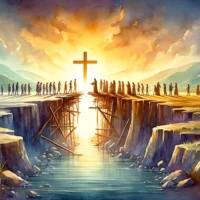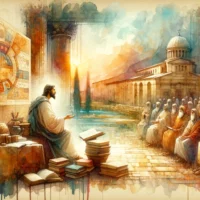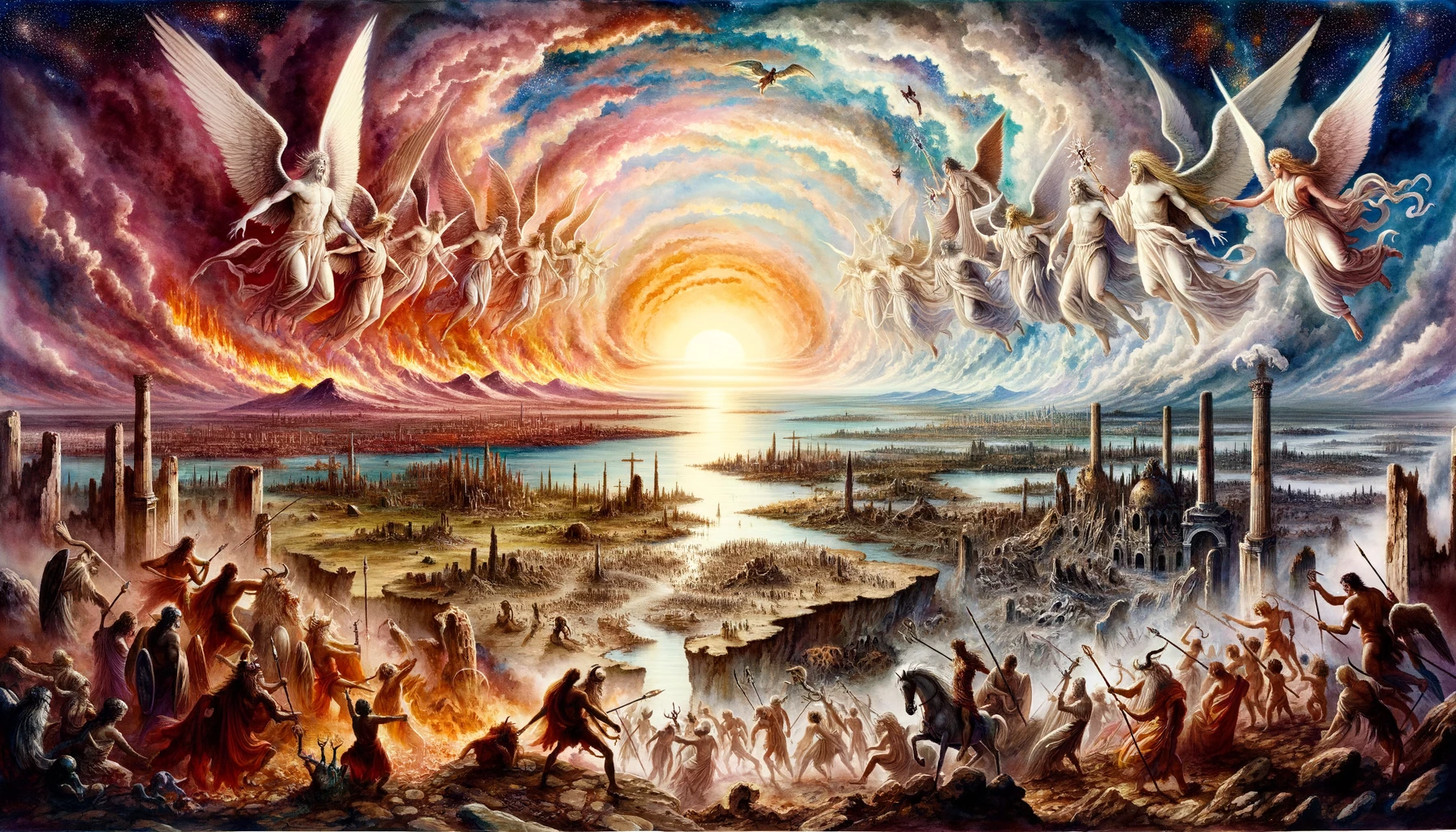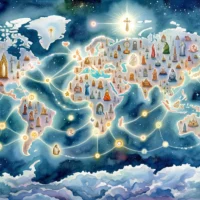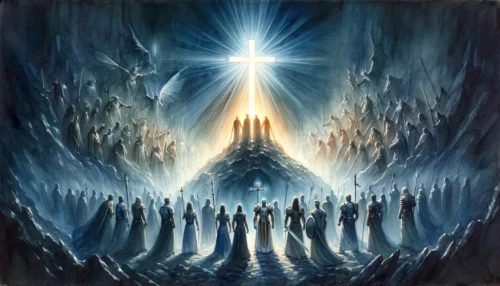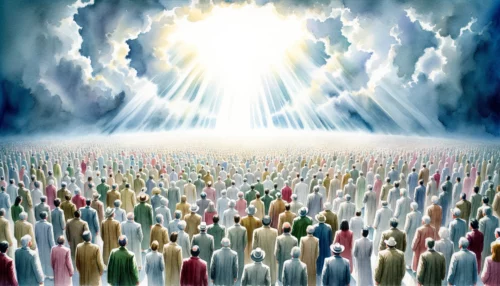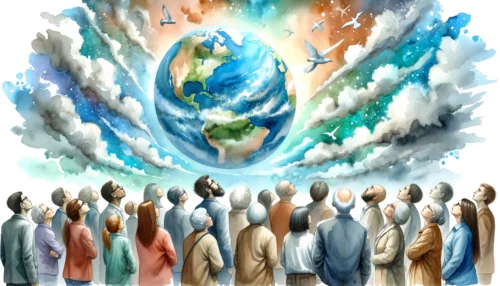Our journey through the labyrinth of apocalyptic literature starts with a brief background on Armageddon, the symbolic location associated with a monumental battle. We continue by discussing the primary biblical references and interpretations concerning this event. Finally, we explore its significance and what it might imply about the culmination of the End Times, always keeping our feet grounded in Scripture, our guide through this intricate and thought-provoking topic.
Armageddon: Background and Meaning
The term ‘Armageddon’ resonates in our collective consciousness, often stirring visions of catastrophic warfare and ultimate destruction. This notion springs from its use in Christian teachings as a symbolic representation of a grand, final confrontation that marks the culmination of human history. Yet to fully comprehend Armageddon’s implications, we must first understand its origin and literal meaning.
‘Armageddon’ originates from the Hebrew ‘Har Megiddo,’ meaning ‘Mount of Megiddo.’ This geographic location in the modern-day country of Israel carries significant historical weight, as it has been the site of many battles across the centuries. Strategically situated at the crossroads of several major ancient trade routes, Megiddo has seen empires rise and fall, underlining its symbolic relevance to a battle of immense proportions (Revelation 16:16).
Armageddon is mentioned solely in the Book of Revelation, the final book in the New Testament, in the context of the last of the seven bowls of God’s wrath. It serves as the gathering place for the kings of the earth and their armies, who are preparing for a monumental battle under the influence of demonic spirits (Revelation 16:14-16).
The Battle of Armageddon is not a conflict between human factions or earthly nations. Instead, it is a clash involving spiritual and supernatural forces. It is envisioned as a cosmic struggle between good and evil, where the forces of God confront and ultimately defeat those of the Antichrist.
While the narrative and symbolism surrounding Armageddon often seem imbued with doom and destruction, they also hold a message of victory. This is a victory not just for the divine forces involved in the battle, but also for the principles of righteousness and justice, affirming God’s ultimate authority and dominion (Revelation 19:11-21).
The term ‘Armageddon’ is derived from the Hebrew ‘Har Megiddo,’ referring to the historically significant Mount of Megiddo in Israel. Mentioned in the Book of Revelation as the site of a momentous future battle, Armageddon symbolises the final confrontation in human history, a clash not between human entities, but between supernatural forces of good and evil. While the imagery may seem laden with devastation, it encapsulates a triumphant assertion of righteousness, justice, and God’s sovereignty.
Biblical References and Interpretations
The Battle of Armageddon is primarily depicted in the Bible’s book of Revelation, where it plays a vital role in the unfolding of the end-time events. The narrative describes a time of intense turmoil, characterized by the unleashing of God’s judgments and culminating in this ultimate battle (Revelation 16:14-16).
Leading up to the battle, the Bible describes a series of calamitous events. These include the rise of the Antichrist, widespread deception, and the pouring out of God’s wrath upon the earth through a sequence of judgements symbolized by seals, trumpets, and bowls. Armageddon specifically takes place following the pouring out of the seventh and last bowl of God’s wrath, marking the peak of this catastrophic period (Revelation 16:17-21).
In the battle itself, it is described that God’s forces, led by Jesus Christ, confront the amassed armies of the earth. These earthly forces are under the influence of the Beast, also known as the Antichrist, and the False Prophet, who have been deceived by demonic spirits into participating in this futile battle against the Divine (Revelation 19:11-21).
Biblical imagery portrays Jesus Christ as a victorious warrior, clad in a robe dipped in blood and leading the armies of heaven on a white horse. The forces of the Antichrist and the False Prophet are utterly defeated, signifying the triumph of God’s righteousness over the deceptive powers of evil. After the battle, the Antichrist and the False Prophet are thrown into the lake of fire, symbolizing their eternal judgment (Revelation 19:20).
Following the Battle of Armageddon, it is predicted that Satan will be bound for a thousand years, a period known as the Millennial Reign, where Christ rules with peace and righteousness. After this, Satan is released for a short time, only to be defeated again and cast into the lake of fire, marking the ultimate victory of good over evil (Revelation 20:1-10).
The Battle of Armageddon takes place amidst a time of intense upheaval marked by the rise of the Antichrist, deception, and God’s judgments. This battle is not merely a physical confrontation, but a spiritual showdown between the forces of God, led by Jesus Christ, and the deceived armies of earth, manipulated by the Antichrist and the False Prophet. The defeat of these deceptive powers signifies the triumph of God’s righteousness, leading to a period of Christ’s peaceful reign, the Millennial Reign. The binding and ultimate defeat of Satan after this period mark the final victory of good over evil. This narrative underscores the significance of the Battle of Armageddon in the larger end-time events.
Armageddon’s Significance in the End Times
Understanding the significance of the Battle of Armageddon in the End Times is fundamental to our Christian faith. This great conflict represents not merely a cataclysmic event in human history but underscores the immutable truths of God’s sovereignty, justice, and righteousness.
The battle plays a pivotal role in the grand narrative of God’s plan for humanity. It marks the culmination of human history as we know it, serving as the apex of the tribulation period, when God’s judgments are poured out upon the earth (Revelation 16:17-21). This climactic battle signifies the end of mankind’s rebellion against God and the onset of a period of divine rule.
The defeat of the Antichrist and the False Prophet, who embody deception and wickedness, underscores the triumph of truth and righteousness. This victorious outcome highlights the ultimate failure of evil and the prevailing power of God’s righteousness (Revelation 19:20). The message is clear – no power, however deceptive or destructive, can stand against the divine authority of God.
The Battle of Armageddon also precedes the Millennial Reign of Christ, a period of peace and righteousness during which Christ reigns for a thousand years (Revelation 20:1-6). This era marks a significant shift in the earthly order, as the dominion of sin and corruption gives way to a time of peace, righteousness, and justice under Christ’s rule.
The events surrounding Armageddon remind us of the inevitability of divine justice. Those who defy God’s rule and align with the forces of evil will face eternal judgment (Revelation 19:20). On the other hand, those who remain faithful to God, even amidst tribulation, are promised the hope of resurrection and eternal life (Revelation 20:4-6).
The Battle of Armageddon, as depicted in Christian eschatology, is of immense significance. It marks the culmination of human history and rebellion against God, signaling the triumph of God’s sovereignty, justice, and righteousness. The defeat of the Antichrist and the False Prophet emphasizes the prevailing power of God’s truth and the ultimate failure of evil. This event ushers in the Millennial Reign of Christ, a period of peace and divine rule. These elements collectively underscore the profound implications of Armageddon in the context of the End Times, pointing to the inevitability of divine justice and the promise of hope for those who remain steadfast in their faith.
Standing Firm in the Face of Armageddon
In studying the Battle of Armageddon, we unearth profound truths of our faith that ground us in the certainty of God’s sovereignty and righteousness. This pivotal event in the End Times serves not only as a symbol of final judgment and the defeat of evil but also as an assurance of God’s ultimate victory. It’s a testament to the unwavering promise of a future where truth, justice, and peace reign supreme under the rule of Jesus Christ.
As we continue our faith journey, let us reflect on these questions:
- How does the symbolism of the Battle of Armageddon strengthen our trust in God’s sovereignty?
- How might the events of Armageddon and the subsequent Millennial Reign of Christ shape our perspective on the enduring nature of God’s righteousness?
- What implications might the inevitable divine justice seen in the Armageddon narrative have on our personal faith and Christian living?
Our faith offers us the strength and fortitude to stand firm, even when faced with the prospect of a climactic battle such as Armageddon. Let the knowledge of God’s ultimate victory over evil serve as a beacon of hope, guiding us through trials and tribulations, assuring us of the promise of a new dawn under the rule of Jesus Christ. Stay steadfast, for our faith lights the path towards God’s eternal peace.


